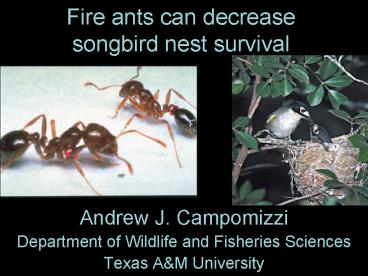Fire ants can decrease songbird nest survival - PowerPoint PPT Presentation
1 / 26
Title:
Fire ants can decrease songbird nest survival
Description:
Northern cardinals. Methods. Treatment nests. Physical barrier. Tree Tanglefoot Paste ... Vireos and cardinals. Ant patterns. Ant activity. Food lures ... – PowerPoint PPT presentation
Number of Views:53
Avg rating:3.0/5.0
Title: Fire ants can decrease songbird nest survival
1
Fire ants can decrease songbird nest survival
- Andrew J. Campomizzi
- Department of Wildlife and Fisheries Sciences
- Texas AM University
2
Outline
- Background
- Objective
- Methods
- Results
- Conclusions
3
Background
Background on red imported fire ants (Solenopsis
invicta)
- Non-native from South America
- Intense forager
4
Background
Red imported fire ants
- Nest predator
- Invasive species
- Management techniques available
5
Background
Black-capped vireo
- Reasons for listing
- Habitat loss
- Brown-headed cowbird
- Current management
- Vegetation restoration
- Cowbird removal
6
Background
- Current Management
7
Background
Black-capped vireo habitat
8
Overlap of black-capped vireo breeding range and
fire ant range
9
Background
Current situation
- Is management working?
- Yes, No, and Maybe
- Additional management options
- Increase nest success
- Decrease nest predators
10
Background
How can we increase nest success?
- Identify nest predators
- Snakes, Fire Ants, Birds, Mammals
- Quantify effect of nest predators
- Can predators be managed?
11
Objectives
- Effect of fire ants on nest success
- gt10 reduction important
- Quantify frequency of ants in nests and patterns
- Quantify ant activity near nests
12
Methods
- Study sites
- All 11 properties with black-capped vireos
- Monitored nests
- Black-capped vireos
- White-eyed vireos
- Northern cardinals
13
Methods
Manipulative experiment
- Treatment nests
- Physical barrier
- Tree Tanglefoot Paste
- Chemical barrier
- Plastic with low toxicity pesticide
- Control nests
- Inert barrier
14
Methods
15
Methods
Trunk
Nest
16
Methods
Observational study
- Frequency of ants in nests
- Vireos and cardinals
- Ant patterns
- Ant activity
- Food lures
17
Methods
Analysis
- Compare nest survival
- Treatment versus control
- Percent of nests with ants
- Percent of nests with ant activity
18
Results
Nest Success
19
Results
Frequency of ants in nests
- 7 of nests had ants (13 of 179)
- No patterns
20
Results
Ant activity near nests
- Ground
- 60 had ants foraging (73 of 122)
- In vegetation
- 7 had ants foraging (9 of 122)
21
Results
Inter-annual difference in ant activity
- Ants detected near nests
- 2006
- 71
- 2007
- 50
22
Results
Conclusions
- Consider fire ant management
- Methods may need to be explored
- Research
23
Acknowledgements
- Land owners
- Field technicians
- Co-authors
- Dr. M. L. Morrison, Shannon Farrell, Dr. R. Neal
Wilkins, Dr. B. M. Drees, Dr. J. Packard - Funding
- Department of Defense, Environmental Readiness
Program - US Department of Agriculture, Natural Resources
Conservation Service - Texas Parks and Wildlife Department
- Logistical Support
- Steve Manning, Texas Watershed Management
Foundation - Brian Hays, Extension Program Specialist
- Institute or Renewable Natural Resources, Texas
AM University
24
Acknowledgements
- Supplies
- Nix of America
- Tanglefoot
- Images
- Cornell University
- Texas Parks and Wildlife Department
- US Fish and Wildlife Service
- Dr. B. M. Drees
- Claire Curry
- Juan Pablo Assmus
25
(No Transcript)
26
(No Transcript)































